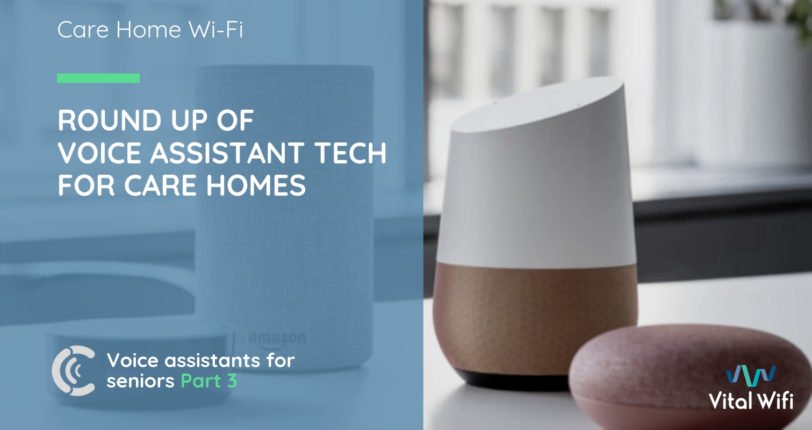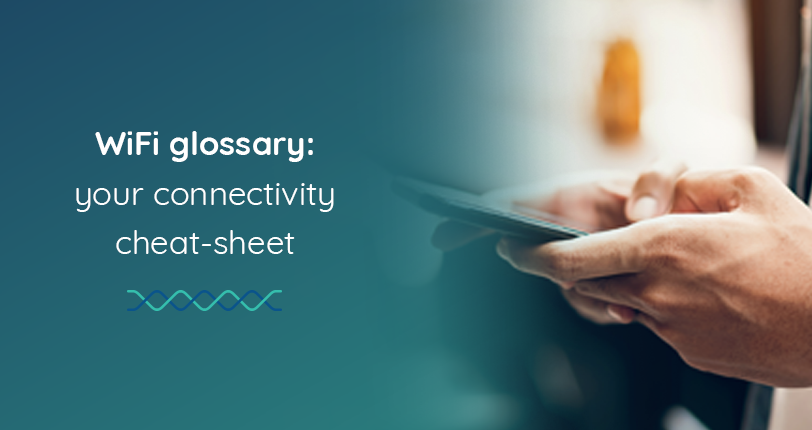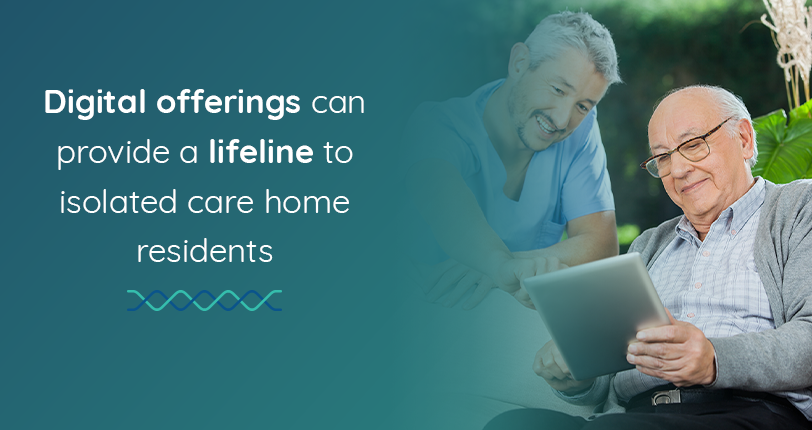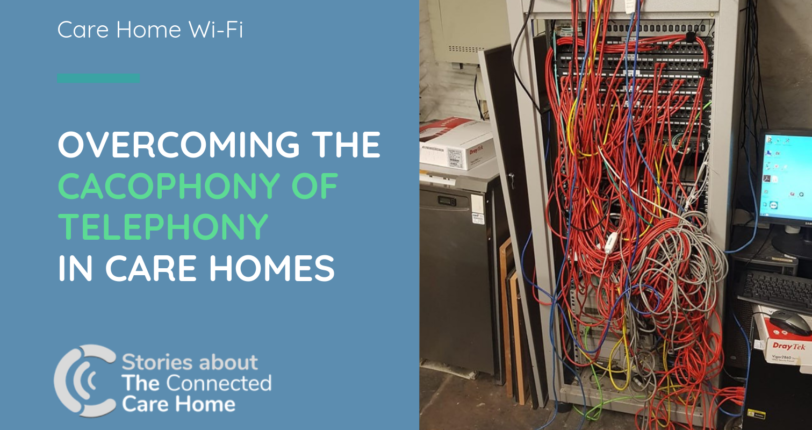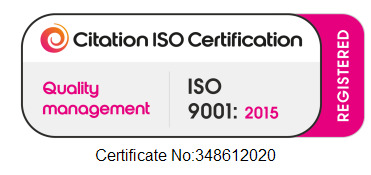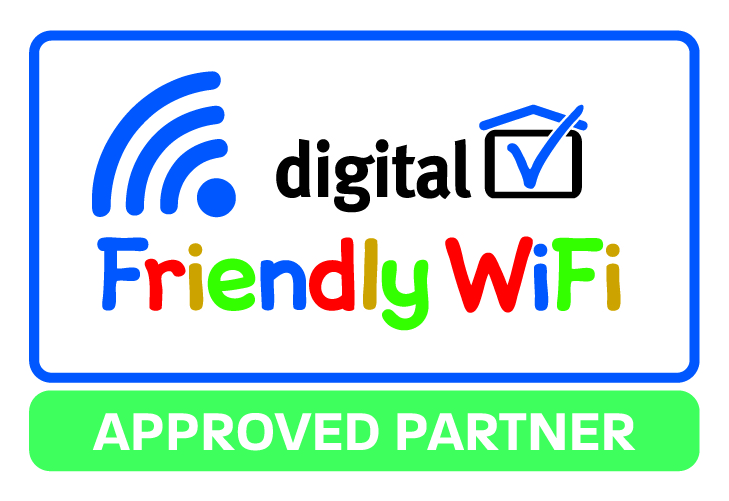As the elderly population grows, new technology is being deployed to tackle loneliness and isolation and to assist with the management of dementia patients that can be run on care home WiFi. But how far can it go to help? Can machines actually offer care and companionship?
Recent developments have shown that voice-activated technology can successfully aid senior citizens and take a load off, caregivers. The consensus is that technology should assist, not replace, human caregivers who are what voice-activated solutions do.
So here we take a look at what ‘voice’ solutions are currently available that a care home could use today. The only requirement is to have care of home WiFi coverage across the premises. Voice assistants vary from off the shelf native phone apps to all singing and dancing (almost literally!) robot assistants.
You can read a broader review in our publication, The Connected Care Home.
What is a Voice Assistant?
A voice assistant is a software agent that carries out tasks for the user based on voice commands. Users can ask questions, control home automation devices and media playback via voice, and manage other essential tasks such as email, to-do lists, and calendars with verbal commands.
In this post, we refer to devices that use voice commands, voice recognition, speech synthesis and natural language processing (NLP) to provide services via specific applications.
Some run on a smartphone, some a smart speaker and some series on their proprietary hardware. Below we present a round-up of voice assistant technologies for care homes to use.
Voice Assistants in Smartphones
These are commonly used for hands-free tasks. Making a call, looking up online, giving directions. However, when coupled with other software applications and integrated with other devices, the ‘voice assistant’ can act like remote control, such as adjusting thermostats, switching TV channels and turning on lights.
These are the native voice assistants to be found on smartphones:
Siri
Well known to Apple users, Siri is ubiquitous on iPhones, iPads, Mac computers, Apple TV, Apple Watch (a watch that can connect to your phone and other Apple devices) and the HomePod – Apple’s home-based system.
Siri is a built-in, voice-controlled personal assistant available. It has access to all the integrated applications on an Apple device – Mail, Contacts, Messages, Maps, Safari and so on – and will call upon those apps to present data or search through their databases whenever she needs to.
Care Home Application
For care homes not wanting to invest in devices, they can encourage residents with Apple smartphones, to use Siri to gain more independence and to engage with suitable apps. Care homes will need a robust WiFi network. Works well when care home WiFi is accessible across the premises.
Google Home Assistant
This is available on Android phones (either built-in directly on certain phones like the Google Pixel and Samsung Galaxy S8) or by downloading the Google Allo app, and Android Wear wearable devices. It also comes as part of the Google Home smart speaker. As well as controlling Google Assistant with your voice, you can type commands and questions for it. Launched as Google Now in 2012 in Android.
Care Home Application
A comprehensive case for Google Home Assistant for Seniors is made on Nurse Next Door. Care homes will need a robust WiFi network. Best when care home WiFi coverage is networked across the whole building.
Bixby
Bixby is Samsung’s personal assistant to be found on Samsung devices. It responds to commands for web searches, requests to download apps and has direct support for a variety of other apps. It can control smart home apps that integrates with Samsung’s proprietary hub.
Care Home Application
As with Siri above. Works best when care home WiFi is accessible across the residence.
Cortana
Cortana is Microsoft’s voice assistant and can make calls, send texts and emails, track packages and enter calendar appointments and more.
Commonly associated with Windows 10, Microsoft’s voice assistant links to its smart home ecosystem. It can also be used with a speaker like Invoke from Harman Kardon. It’s named after a synthetic intelligence character in Microsoft’s Halo series of video games. It’s available for Windows 10 Mobile, Windows 10 PCs, the Microsoft Band fitness tracker, Xbox One games console, Windows Mixed Reality headsets and the Android mobile operating system.
Delivers exceptional sound, and with Cortana’s intelligence, you can voice control your music and smart home devices, create reminders and lists, manage schedules, get answers to questions, make and receive hands-free calls with Skype, and more.
Vital WiFi’s View
For many elderly residents, a smartphone is a confusing and scary device, and many may not own one, or if they do, are reticent to use it. This is where ‘smart speakers’ like the Amazon Echo have become popular with elderly users.
Voice Assistants in Smart Speakers Using Care Home WiFi
Below is a selection of voice assistants that are accessible via special smart speakers.
Amazon Echo Range
Alexa is Amazon’s voice assistant. It comes as part of its Amazon Echo range of speakers and is available as an Android or IOS app for smartphones and tablets. This can be used with Alexa ‘skills’ apps like myNursebot or Medicine Tracker to track medications and symptoms. Alexa can also be found on speakers and devices built by third parties.
Google Home
Google’s competitor to Amazon’s Echo, this is an intelligent smart home hub and capable ‘assistant’. While Google has been a leader in AI for a long time, Amazon’s Alexa has many “skills” which does set it apart.
Apple Homepod
The HomePod is Apple’s smart speaker, controlled using Siri with AirPlay 2 support, phone calls and more. This is possibly stronger for the home market with an emphasis on home entertainment integrations. The HomePod 2 is likely to have more advanced functions such as facial recognition authentication. Nonetheless, being Apple, it’s expected to only ‘play nice’ with other Apple products.
Voice-based Devices with a screen
1. Google Home Hub
Google Home Hub supports over 5000 smart devices from 400 companies making it very versatile.
2. Amazon Echo Show (2nd generation)
The addition of a screen gives a much higher potential for how Alexa can be used in the care home.
3. Amazon Echo Spot
A more compact Echo with a camera – this may present privacy issues for some.
Vice-Based Solutions for the Care Home
Here is Vital WiFi’s round-up of 11 voice-based solutions to help elderly residents that can be used with care home WiFi.
What it is: Lisa (Learning Interface for Senior Adults) is a voice assistant and companion that works with Amazon Alexa and Google Assistant smart speakers and other voice-enabled devices. Designed for seniors to send and receive messages without the need for a PC or phone. Coaches to maintain healthy habits. And offers community entertainment and news sharing facilities.
Location: California, USA
Key features: Messaging, Coaching, News and Event Prompts, Companionship, Alerts, Voice Services
What it is: Their stated mission is “to improve the quality of life for caregivers and their loved ones, providing voice-first, intelligent and connected services and solutions for greater peace of mind and better health outcomes.”
Key features: Check-ins, Reminders, Companionship, Alerts, Voice Services
Location: Boston, USA
What it does: This voice-activated home health companion delivers therapy reminders, health information, and companionship to keep your care plan on track, no matter what you’re dealing with.
Location: New York, USA
Key features: secure pill storage, question answering, facial recognition, communicates notifications to carers, video calling
What it does: Orbita provides the gold-standard enterprise platform for healthcare organisations to securely design, build, manage and optimise AI-driven voice and chatbot applications across omnichannel environments
Key features: automation of common inpatient clinical and support tasks, e.g. a virtual bedside assistant that provides concierge services, safety rounds, pain management, and facility wayfinding. Remote patient monitoring.
Location: Boston, USA
ELLIQ
What it is: ElliQ is a smart robot and personal voice assistant for the elderly. It comprises a small robot with a swivelling head, a removable tablet and cameras. It can play music, send and receive messages, manage a calendar and play videos. ElliQ won the 2018 CES Best of Innovation Award, a sizeable coveted research grant with Center for Aging and Brain Health Innovation (CABHI), AI Breakthrough Award, Fast Company Design Award and more. Currently available to pre-order.
Key features: Video Calls and Messaging; cognitive stimulation and games; curated music and videos; photo-sharing; calendar and reminders; news and weather; daily routine reminders; question and answer
Location: Israel
What it is: Marvee is more for those wanting to build and develop their solution, as they have the expertise to do so. Marvee is a Voice-First Strategy & Voice Design company creating voice experiences for older adults, families and caregivers.
Key features: Sends out a morning beacon ‘I’m OK’. Request visits. Check on me. Ask about family news — management via an online portal.
Location: USA
What it is: RemindMeCare is person-centred care, activities and companionship software, available as an app integrated with Alexa.
Key features: remote management, activity scheduling and in-room event reminders; control in-room entertainment; provide spoken books for those with sight impairment
Location: Teddington, United Kingdom
What it is: Seniors and families can listen to seniors’ schedules, menus, care plans and reminders with any Alexa-enabled device.
Key features: Care requests, notifications.
Location: USA
What it is: Empowered Caregiving with Amazon Alexa. The caregiver support platform improves collaboration and access to information for your entire care team. Seniors and care recipients talk to Alexa to ask for assistance in an engaging voice experience
Key features: Care requests, notifications, voice access, knowledgebase, care concierge
Location: Austin, Texas
What it is: Hands-free communications and caregiver workflows backed by Amazon’s Alexa fund and Google Assistant investment program.
Key features: Caregiver task management, and instant messaging, routing voice requests to caregivers
Location: California, USA
What it is: Using Amazon Alexa, this is for seniors wanting to recollect memories from their earlier life and share them with family and friends.
Key features: Uses archived historical content which is served up from voice commands
Location: New York, USA
Conclusion
As amusing as it is to ask Alexa to tell us a joke, voice assistants are far from fun and not a fad. They are changing how people behave and interact with the world. The ‘smart speaker’ may disappear in time, but voice assistants will be embedded in all people-facing technology from TVs to fridges. Kids won’t believe there was once a time when you couldn’t speak to things.
Already Alexa and Google Assistant can be found in cars, bathroom mirrors, and even smoke alarms. Machine learning and AI will only improve, and voice assistants will get smarter still.
The voice technology that is available today is inexpensive and very accessible for elderly users. So long as a care home has WiFi coverage across their premises and reaching residents’ rooms, then some form of voice assistant tailored for care makes a lot of sense.
The key is the WiFi infrastructure. Get that right, and you can open many doors to savings, efficiency and higher well being for residents.
While Voice Assistants in care homes do not require linking to a smartphone, they do mostly require a robust WiFi network. Care homes interested in upgrading their system can apply for a free site survey and report from Vital WiFi, a specialist in deployment and management of WiFi in care homes.
SeniorConnect is a managed WiFi system that requires little or no upfront investment and can be funded from the operational expenditure. Implement new technology into your care homes and contact us.
Jargon – Acronyms Describing a Voice Assistant
- VUI – Voice User Interface
- IVA – Intelligent Virtual Assistant
- VA – Voice Assistant
- IAT – Intelligent Assistive Technology
- CCD – Consumer Connected Device
- AI – Artificial Intelligence
- IVA – Intelligent Virtual Assistant
